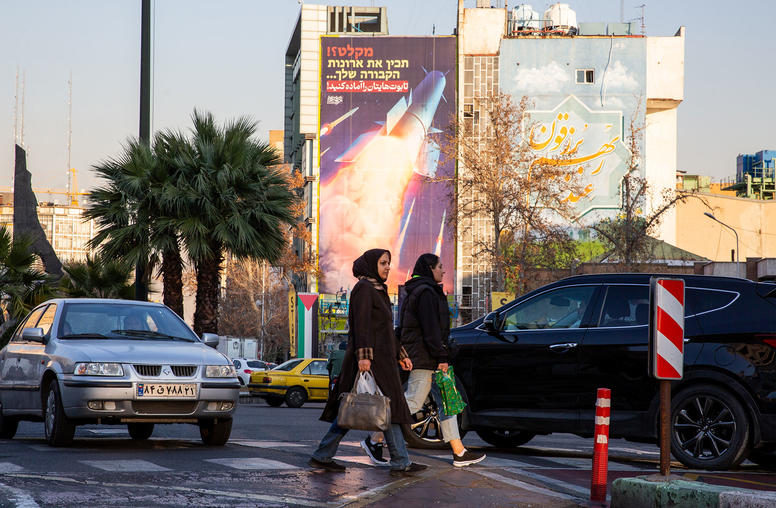Sanctions and Saber-Rattling
As part of its expertise on conflict management and resolution, the U.S. Institute of Peace focuses on how resources can be a source of division and conflict, and how to mitigate such potential problems. With tensions on the rise in the Middle East, and the jump in gas prices, USIP’s Raymond Gilpin addresses the immediate issues facing the U.S. and the world regarding the cost of oil.

As part of its expertise on conflict management and resolution, the U.S. Institute of Peace focuses on how resources can be a source of division and conflict, and how to mitigate such potential problems.
With tensions on the rise in the Middle East, and the jump in gas prices, USIP’s Raymond Gilpin addresses the immediate issues facing the U.S. and the world regarding the cost of oil.
How do the current tensions with Iran, and inside Syria, potentially affect global oil prices?
Although the United States and the European Union have announced a set of financial sanctions designed to cripple Iran’s oil exports and hopefully force Teheran to rethink its controversial nuclear ambitions, Iran appears undeterred. Iran’s intransigence (in defiance of U.N. Security Council resolutions) is increasing the likelihood of a potential military confrontation. Iran has threatened to retaliate by blockading the Strait of Hormuz. Concerns over growing tensions have pushed oil prices significantly above the $100 barrel mark, as futures traders react to potential supply disruptions. Although Saudi Arabia could probably compensate for a temporary loss of Iran’s 2.5 million barrels per day, disruptions in the Strait of Hormuz could affect the daily transit of some 17 million barrels and have a much deeper impact on global prices. Syria, on the other hand, exports fewer than 400,000 barrels and is less likely to have a big impact on global supply. However, continued unrest in that country could become a regional problem and eventually edge prices further upwards. Global oil prices are particularly sensitive to any supply disruptions because global demand remains strong. In the U.S., the seasonal spike in demand in the run-up to peak travel season adds to the dilemma. Most analysts anticipate a relatively modest 10 to 15 percent increase in U.S. pump prices if there is a significant short-term disruption; partly because the U.S. does not import from Iran. If the conflict worsens and world prices skyrocket, the impact could be much more severe.
Would economic sanctions make a difference?
Economic sanctions are not intended to punish the citizens of a country. In the case of Iran, the primary aim is to discourage Iran from pursuing a nuclear weapons program and to allow the international community to ensure demonstrable transparency via regular inspections. With Syria, the overarching goal is to put an end to the indiscriminate killing of Syrians and the introduction of a more accountable system of government in that country. Two important things should be noted about economic sanctions. First, they typically take a long time to have any meaningful impact. Time is definitely of the essence in this context because Iran’s nuclear program is gathering pace while we wait for the sanctions to bite. Nations that are jittery about nuclear ambitions are growing increasingly nervous as they fear that Iran would have developed critical nuclear capacity long before the sanctions tighten the screws on the regime and force change. In Syria, countless die every day we wait. Second, sanctions need to be fairly comprehensive if they are to be meaningful. Since the demand for Iranian oil is unlikely to wane over the near term and both Iran and Syria continue to receive material and moral support from a number of countries, the anticipated impact of financial sanctions will be cushioned and the respective regimes will be much less amenable to change.
Would economic sanctions risk a response from Iran?
Iran halted the sale of oil to the UK and France in retaliation. However, these countries do not buy a lot of oil from Iran and according to a number of analysts, Iran is finding it difficult to find new buyer for an estimated 500,000 barrels of oil freed up by this action. Iran has also threatened to blockade the Strait of Hormuz. However, such a move could prove counterproductive, since roughly 60 percent of the traffic benefits Iran’s major Eastern markets and supporters. In addition, Iran will find it extremely difficult to develop new markets. Neither strategy is likely to be effective because Iran has relatively little scope to use its oil as a strategic weapon.
Have economic sanctions failed?
While it is clear that economic sanctions are having an effect in both countries, an exclusive reliance on economic sanctions will embolden the regimes in both Teheran and Damascus. Sanctions should be made more comprehensive in scope and coverage. They must also be buttressed by muscular diplomacy and credible security initiatives. Time is of the essence. In Syria, we risk a prolonged civil war, which could affect the region. The Iranian crisis threatens the prospect of a nuclear conflagration. Many believe that economic sanctions are being used as a signaling instrument to buy time for negotiations and/or an eventual compromise. This is a risky strategy since the stakes are so high and time is running out. Immediate steps should be taken to accelerate the process by strengthening the sanctions regime while concomitantly (not sequentially) pursuing credible diplomatic and security support.



